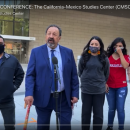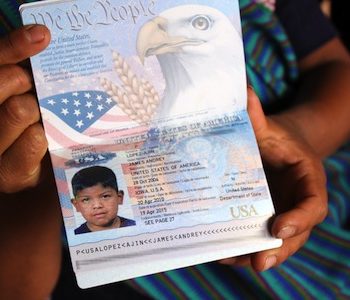By Dr. Gonzalo Santos, Exclusive for El Magonista ~ April 26, 2021
This April 17, one-hundred-and-fourteen years ago (1907), marked the busiest day in the history of Ellis Island - the main and most famous port of entry for European immigrants. That day, 11,747 prospective immigrants arrived.
All in all, between the 1880s and the 1920s over 36 million Europeans arrived to the United States. But have you ever wonder how come so many Europeans came in the late 19th and early 20th century and then stopped coming? All we hear nowadays from their descendants, who have turned ironically nativist, is "They came legally."
Oh, really? Well, they were blocked legally, too!
Let’s first place this migratory wave in its global context. It was part and parcel of the Pax Britannica – the world order run by Great Britain, the global hegemon of the time. Human migration flows in the world-economy were bifurcated in character and destination.
The bulk of the European migrants went freely to the United States, meaning under a regime of free wage labor, and to other parts of the Americas (Brazil, Argentina, Cuba). A significant flow went to European colonial possessions in Africa and Asia – mostly British - as settlers, soldiers, and colonial administrators.
The bulk of Asian and African migrants, in contrast, went mostly to other parts of Asia and Africa, not as independent agents but as contract laborers under various coercive arrangements.
Though the United States was the main country of destination, millions of other Europeans migrated throughout the Americas and to the British far-flung colonial possessions in Africa, Asia, and Oceania. The main characteristic of this vast migration wave out of Europe, which began in earnest after the Napoleonic Wars and grew unabated until World War I, was that it was “free” – that is, it was unrestricted, unlimited, and voluntary.
Interestingly, the U.S. in the 19th century was also the main recipient of foreign investment – in other words, the U.S. was the main magnet for both European capital and labor. That’s actually how it was able to become an imperialist nation-state by 1900, having defeated Spain in 1889 and established colonies in Asia and the Caribbean.
So, during this era of U.S. expansion and consolidation, European “legal migration” meant showing up - not so for Asians or Africans, who had been legally barred from coming to the U.S. starting in 1882, using old racial criteria for naturalization as new grounds for immigrant exclusion (the Filipinos were for a while the sole exception, having been declared “U.S. nationals”).
I say new because racialized African slaves were not barred in the prior three hundred years, and the new republic even went to war with Great Britain for banning the slave trade. But the passing of the 14th amendment after the Civil War –granting birthright citizenship to children of immigrants of any race – was the last straw for the now-alarmed white nationalists.
European immigrants, on the other hand, were fine – at the beginning – despite grumblings about their Catholicism or Jewishness. As long as the arriving European migrants did not show any signs of having a contagious disease, they were let in - and for those who were sick a quarantine hospital treated them within the grounds of Ellis Island, and once recovered, released.
Why were Europeans allowed in so easily? The short answer is that the United States, in the midst of its mighty industrialization, financed by global capital and driven in its continental territorial expansion, needed all the workers and settlers it could get, as long as they white – whatever objections the strident WASP (White Anglo-Saxon Protestant) nativists of the time raised (the Know Nothing Party before the Civil War, the KKK afterwards).
But after the U.S. reached its territorial limits and the frontier was closed, a significant sector of the WASP elite itself turned nativist - not just white nationalist but WASP nationalist -, devoting ample ideological, political, & financial resources to the growing protectionist labor movement and major middle class social movements.
For example, the women’s suffragette and temperance (anti-alcohol) movements. The women’s movement was initially opposed to Black male enfranchisement ahead of white women, and in the early 20th century embraced anti-European xenophobia to advocate for their voting rights, and the same happened among those advocating “prohibition.”
It is not a mere coincidence that both movements won in 1920 by arguing that proper Anglo-Saxon women should be given a higher priority in extending American voting rights than to grant them automatically to those drunken, degenerate non-WASP white immigrant males allowed to naturalize due to their morally-dubious, biologically-inferior whiteness.
The “scientific racists” of the era - all of them elite WASP “eugenicists” perched at the most prestigious universities (Harvard, Stanford), appeared at congressional hearings and published “scientific” books and articles in the press purporting to “prove” that the millions of incoming non-WASP Europeans were not even real whites, but constituted biologically inferior races, hereditarily prone to criminality, feeblemindedness, and morally depraved behavior.
Their “stock” was deemed genetically subpar, and their unchecked intermingling with the “original American stock” of WASP Americans, a cause for great alarm; the “Anglo Saxon race” was in imminent danger of irreversible degradation!
By 1924, not only did white women could vote and alcohol was banned, all Non-WASP European migrant flows were capped at extremely restrictive “national quotas” - no more than a hundred or so a year -, and Asians as a whole were entirely excluded. In the meantime, yearly quotas for immigrants from the WASP-origin areas of Northwestern Europe were in the tens of thousands. That is how, by the way, Donald Trump’s Scottish mother immigrated.
This state of affairs lasted until the end of World War II. After the war, U.S. nativists tried to prevent war refugees from coming. But they were defeated by those that denounced the turning back to their deaths of desperate Jewish and other refugees fleeing the Nazis, under the terms of the National Quota Act of ’24.
This helped delegitimize the racist foundation of the entire law. In the 1950s and 60s, ethnic whites and their liberal WASP allies fought for comprehensive immigration reform and finally won in 1965, elevating the principle of unrestricted family unification and refugee rights to primacy.
To assuage the WASP nativists, they argued that for a nation with an overwhelming white population, the nativists should not fear abolishing all racial criteria for admission – after all, there were many more white families than otherwise. Whiteness itself would become consolidated, through demography rather than those insidious racial codes, in the post-Jim Crow era now being inaugurated!
The irony, of course, is that for global geopolitical reasons (the U.S.-led Cold War world order), the U.S. tremendously and immediately helped Western Europe reconstruct after the war, which led to much fewer Western Europeans actually out-migrating (Eastern Europeans were locked behind the “Iron Curtain”).
Western Europe itself quickly became a destination for vast flows of intra- and extra-European in-migration of new “guest” workers, “Commonwealth subjects,” etc.
So, as the U.S. Golden Gate reopened again to a confident, more tolerant, prosperous, and welcoming nation, the bulk of the immigrants and refugees came from Latin America and Asia, many as a direct result of U.S. wars, others irregularly due to unrealistic hemispheric and national “caps” for legal visas outside the family unification and refugee tracks (the latter granted selectively along Cold War criteria, to those fleeing hostile anti-U.S. regimes and denied those fleeing allied ones).
Mexico, in particular, went from a yearly circulation of legal temporary contract migrants to the end of the Bracero Program and the capping of non-family visas to 20 thousand per year – a pittance. The same migrants went from legality to illegality in a flash.
Henceforth, nativists had to develop new rationales of exclusion other than racial criteria, and, very quickly they did. Of course, the main one they fastened to was illegality of status, but not as a civil infraction that could be remedied with better policy and diplomatic treaties, but as an existential threat to the nation!
During the height of the Cold War, recurrent hysterias were based on anti-Communist fears, spilled over to demand closing the borders to migrants, now seen as a “national security threat!”
After the Cold-War ended, nativism shifted its “scavenger” ideology of exclusion to anti-terrorist (code for anti-Muslim) fears. Other strains of white nationalisms developed also since the 1960s, in the midst of prosperity, based on fears for (non-white) overpopulation & environmental degradation.
Throughout the liberal era, there have been recurrent and exaggerated fears of massive freeloading by immigrants off the benefits of the welfare state, of labor displacement and “unfair” labor competition. These variants resonated with the previously segregated labor movements, barely tolerating domestic racial integration and drawing the line with “foreigners.”
It was not until the “Reagan Revolution” – which also had domestic racist overtones denounced at the time as “dog whistles” and “coded speech” – that full-throttle xenophobia gained ascendancy again, by the likes of Pat Buchanan and Lou Dobbs.
From the mid-1990s onwards, the various strains of American paranoia against mostly Latin American and Asian immigrants who came as workers, as families, and as refugees or asylum-seekers – gained steam under the accumulated weight of recurring economic troubles brought about by neoliberal globalization; and this led to a second closing of the Golden Gate of unfettered immigration, the extensive criminalization of migration during the Clinton presidency, and the erection under Bush II and Obama, of a vast bureaucracy of “enforcement” – the Detention/Deportation Industrial Complex, or what I call the American Gulag – that has led to today’s extremes of callousness, chaos, and egregious human rights violations.
This is not unrelated to the anti-Black white backlash to the ascension of the first Black president to the White House, Barack Obama, which fueled the rise of virulent, openly racist, anti-Semitic, and anti-Muslim xenophobia, and the consolidation of the Republican Party as a white nationalist party during the Trump presidency.
The coup attempt at the Capitol on January 6, to prevent Joe Biden from being certified the winner of the 2020 elections, the fact that Trump won more votes than any other president in history other than Biden, and the fact that the GOP remains unrepentant and emboldened in pursuing its campaign of voter suppression and conquering power by appealing to xenophobia and white grievance, shows American democracy itself is at the verge of collapse, unless the neofascist threat to it is confronted and defeated – a task that requires not just denouncing systemic racism and building a more just and rational alternative, but systemic xenophobia and building a more just and rational alternative as well.
These two tasks go together in today’s globalized and domestic contexts, quite distinct than a century ago, when the citizens of the United States thought of themselves as a Great White Republic and a rising world power.
Today, facing global challenges as climate change and global inequalities, and domestic challenges as how to preserve and improve our democracy and our social contract, either all of North America heals and move on jointly, under a new, more inclusive, shared, transnational social contract, or the region as a whole will be left behind as an ever-more conflicted area, its constituent nation-states with their extensive diasporas in each other’s territories, and settled domestic ethnic groups succumbing to self-made conflagrations sparked by unrestrained, resurgent racism and irrational xenophobia.
The body politic of our respective nations and peoples are gravely afflicted by the prevalent nativist and racist viruses, and the worst may yet to come if we do not inoculate ourselves for both and do it in time.
I submit to you that migrants are a key ingredient of any successful vaccine. The issue is not whether the regional migrants within North America – in transit or settled, internally displaced or crossing international boundaries, legal or unauthorized, voting with their feet in caravans or on their own, launching labor strikes, or through their allies’ votes, - will play a central role as subjects of their own history and the region's future, and change the entire social, economic, cultural, and political landscape of North America, despite all the obstacles put along their way.
They have been, are, and will.
The issue is not going away, and much less will it be "managed" by the region’s governments cooperating to “enforce” ever harsher, coercive measures – not even milder, partial “dissuasion strategies” such as the one just floated by the Mexican president to reduce human migration through localized development initiatives tied to certain migration opportunities.
The sort of initiatives required need to be much larger, much bolder and visionary, akin those taken by the European Union. But absent them one thing is certain: no matter how "coordinated" the area’s political regimes may work on intercepting, detaining, deporting and punishing immigrants and refugees seeking a survival, they will fail, as they have up to now, and only exacerbate our ongoing, man-made, humanitarian and social crisis within the region of North America, for which we are all ultimately responsible for.
The migrants - in caravans, as Dreamers, outside and inside detention centers, striking and disobeying as they leave their homelands, in transit, settling, finding work and starting businesses, and also politically mobilizing themselves and their allies - will not be stopped, let alone be defeated.
They may experience, as they have over the past 30 years, severe setbacks and daunting barriers, but they represent the future of North America. Those that would repress them, despite their many draconian laws and erected gulags, will fail, for they represent the past.
The future is ours if we dare to choose wisely, but only as We, Norteamericanos.
By Dr. Gonzalo Santos, Exclusive for El Magonista ~ April 26, 2021







